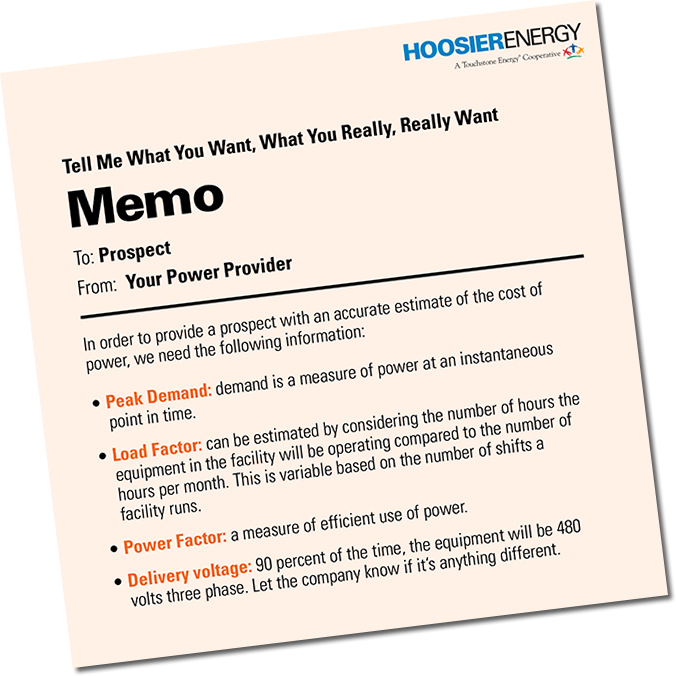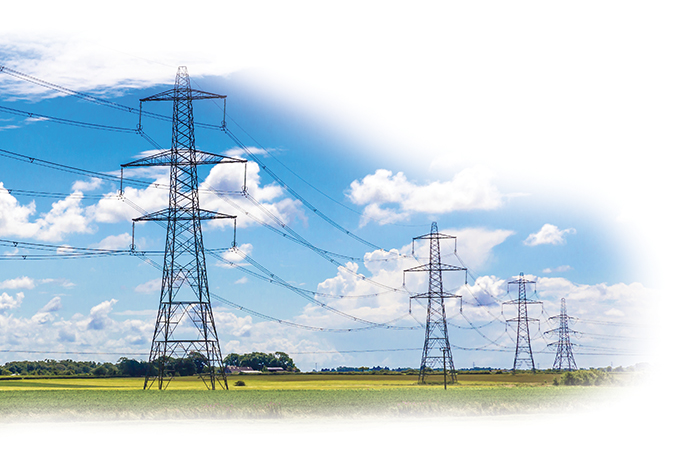Any relationship starts with a question. Ask the right questions, get the right information. You don’t always get the answers you hoped for, but at least you can make an informed decision. The same thing is true in economic development relationships. When a company is looking for a place to invest and a site on which to locate and build, the questions are legion. Successful decisions are made when executives have the right answers to the right questions. Unfortunately, the inverse is also true — ask the wrong questions, get the wrong answers, make the wrong decisions. When it comes to questions about power, providers are often given too little information and asked for a bottom-line power rate.
“I call it blind dating sometimes,” says Corey Murphy, president and CEO of the New Castle/Henry County Economic Development Corporation. “Sometimes it’s speed dating too. The consultants, whether it’s a site selection consultant, whether an external or an internal company team, have a job to do and they’re looking for the best location for their new investment. They send out an RFI [request for information] or an RFQ [request for qualification]. A lot of times they’re asking us to fill out a questionnaire or spreadsheet, a lot of times we don’t know who it is, and that’s fine as well. But they’re evaluating the sites based on the answers on the spreadsheet.”
Murphy’s job is to give companies the most accurate, reliable quote possible for power costs, but he routinely finds his hands are tied due to lack of information.

“We get very few inputs, but are asked to provide a very specific per-kilowatt-hour cost,” he says. “So we provide a specific per-kilowatt-hour cost in that spreadsheet box and we’re high, but it’s because we’re strictly following the information they provided and the information they provided is actually wrong, and we know it’s wrong. It’s kind of a Catch-22.”
Thanks to technology, RFI timelines have shortened. Some requests are expected back in a little as two to three days. Depending on the type of project, he might be working with a site location consultant, in which case a direct conversation can quickly take place. But sometimes the state EDO is acting as the middle man, adding another layer of communication channels. Often the shortened timeline keeps folks like Murphy from getting the clarification they need to put together the most accurate RFI.
“This is not a complaint about the site selection process,” Murphy adds. “I actually embrace it. We do our best to respond quickly and accurately and to answer the questions that are asked. But it’s a challenge when there’s that huge disconnect.”
“It can definitely slow the process down,” says Chuck Martindale, senior economic development coordinator for Hoosier Energy. “We have to go back to the source for the variable information which they’ll either give to us or will alienate them and they’ll move on.”
So what’s a power company to do?
Getting Beyond the Blind Date
Wouldn’t a basic checklist of information needed by the power company solve the problem? You bet, says Shannon Thom, CEO of Henry County Rural Electric Membership Cooperative (REMC), a member of Hoosier Energy, an 18-member distribution cooperative in central and southern Indiana and southeastern Illinois. “I tried to take it down to the brass tacks, pinpointing exactly what I need to know,” he says. Thom compiled a concise list of questions that must be answered in order to provide an accurate quote (see memo), but it boils down to three or four essential items: peak demand, load factor, power factor and in some instances, delivery voltage.
Martindale agrees. “For us to calculate the cost of electricity, and also the availability, we need to know what voltage they want delivery at,” he says. “We need to know what their peak demand is — demand being kilowatts or KVA — also the load factor, the energy utilization based on the demand. It’s also good to know their power factor; it’s essentially the efficiency of the power. I don’t think any electric utility can give prospects a firm estimate until they have those components they need for the calculation. The more detail we get in on the front end, the better the response will be.”
There’s more to this issue than simple ease of doing business. Projects can be won or lost based on the initial estimate, making it all the more essential to get the estimate right — or as close to right as possible.
“Businesses might be missing out on locating in Henry County where there’s a great workforce and a great community with things we have to offer that have nothing to do with power,” Thom says. “And all because we didn’t get the right information.”
“If I have those four things, I can give them what they want to have,” he adds. “After we get through this part usually they’re asking questions like ‘How far away from the property is the substation?,’ ‘Will we have additional costs for construction,’ or ‘Who owns the transformers?’ We can get to those things, but the initial information is the key to getting beyond the blind date.”
This Investment Profile was prepared under the auspices of Hoosier Energy. For more information, visit www.hoosiersites.com or contact Harold Gutzwiller at (812) 876-0294.

